Other Attractions
Nakon Nayok is best known for its rivers and waterfalls but there are a few other attractions and activities to entertain visitors.
Ganesha Park
Ganesha Park (or Ganesh Park) is an impressive tribute to the Hindu god Ganesha. Although Ganesha is a Hindu god he is also revered by Buddhists. In fact there are many common themes between Hinduism and Buddhism with both religions believing in the concept of re-incarnation, the cycle of life, death and rebirth. Ganesha is the remover of obstacles and the lord of learning.
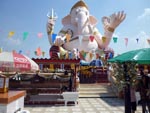 Ganesha is called Phra Pikanet in Thai. He has the head of an elephant with a single tusk, the other having been broken off. He has a pot belly and has been portrayed with a various number of arms. The images at Ganesha Park portray him with four arms.
Ganesha is called Phra Pikanet in Thai. He has the head of an elephant with a single tusk, the other having been broken off. He has a pot belly and has been portrayed with a various number of arms. The images at Ganesha Park portray him with four arms.
Ganesha Park opened in 2008. The project was initiated by Bangkok monk Luang Por who donated the land to build a place of worship for both Buddha and Ganesha.
There are two Ganesha images and they are the largest Ganesha images in Thailand. The first shows Ganesha in a sittting position. This image is 15 meters high and 9 meters wide. He is holding his broken tusk in one hand. In his other hands he has a mahoot's (elephant trainer) hook, a rope noose and a rosary. In front of the sitting Ganesha is a mouse. It is said that Ganesha uses the mouse as a vehicle to communicate with his followers. Hence the reason why you may see worshippers whispering into the mouse's ears.
 The second impressive Ganesha image was added to the park two years after it opened. It is a reclining Ganesha and is 9 meters high and 15 meters wide. This Ganesha has a cobra wrapped around his neck with its hooded head arched up on Ganesha's stomach. Again he is holding his broken tusk in one hand. He has a lotus bud in another hand and is showing a sanscript symbol on the palm of another.
The second impressive Ganesha image was added to the park two years after it opened. It is a reclining Ganesha and is 9 meters high and 15 meters wide. This Ganesha has a cobra wrapped around his neck with its hooded head arched up on Ganesha's stomach. Again he is holding his broken tusk in one hand. He has a lotus bud in another hand and is showing a sanscript symbol on the palm of another.
Ganesha Park also includes a garden, some beautiful shrines and a small museum. It has become common for many Thais to make a little pilgramage here before heading on to the rivers and waterfalls. Ganesha Park is just off route 3049. Drive out of Nakhon Nayok on route 3049 for approx 6km and then turn left at the traffic lights and you can't go far wrong.
Khun Dan Prakan Chon Dam Museum
 The Khun Dan Prakan Chon Dam Museum is a pleasant attraction that tells all you might want to know about the dam in both Thai and English. It includes the history behind the need for the dam and all the technical specifications of its construction.
The Khun Dan Prakan Chon Dam Museum is a pleasant attraction that tells all you might want to know about the dam in both Thai and English. It includes the history behind the need for the dam and all the technical specifications of its construction.
What is also nice is the museum includes a lot of background information on Nakhon Nayok's history, geology and geography. There is also an excellent section on the history of mankind's water management projects from the ancient Egyptians all the way forward to some of the greatest modern day dams around the world.
The museum is generally only open at the weekends and the entrance fee is a mere 20-baht.
The museum is located in front of the Khun Dan Prakan Chon Dam. When you reach the traffic circle with the elephant fountain in the middle you turn right and the museum is immediately on your left.
Trekking
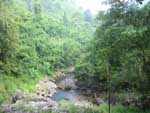
There are some good day treks around the foothills of Khao Yai National Park. They start from the bases of Sarika Waterfall and Nang Rong Waterfall. You should always get permission from the park rangers before commencing a trek.
Alternatively, you could take a 2 or 3 day trek into the center of Khao Yai. Note that you need to book the overnight trekking trips in advance with the Tourism Authority of Thailand, Nakhon Nayok Office, tel: 037 312 282 or 037 312 284.
Golf
 Royal
Hills Golf Club is a beautiful championship standard golf course
at the foothills of Khao Yai. You will need to navigate your way around
the hills while avoiding the streams and lakes that punctuate the course.
There are bargain green fees with weekday rounds available from as little
as 800-baht.
Royal
Hills Golf Club is a beautiful championship standard golf course
at the foothills of Khao Yai. You will need to navigate your way around
the hills while avoiding the streams and lakes that punctuate the course.
There are bargain green fees with weekday rounds available from as little
as 800-baht.
The club also has excellent facilities with a fabulous clubhouse that includes a restaurant, lovely swimming pool, karaoke rooms and children's playroom. It all makes for a golfer's dream.
The club is on the road to Nang Rong Waterfall, approx 14km out of town.
There are a few other less plush golf courses around the Nakhon Nayok province. There is a very nice 18-hole course at the Chulachomklao Royal Military Academy which only costs 800-baht during the week.
ATV (All Terrain Vehicles)
ATVs are a fun way to bobble across some of the rougher local terrain. You can hire ATVs for a small fee. From as little as 100-baht, you can have a fun drive around local dirt track circuits.
From around 500-baht, you can go for a guided tour around the local forest trails.
Paintball
If you want to take a break from the water, there are a few paintball parks. Get a little group together and go to war. Afterwards you can jump back in the water to cool off.
You need a large group for paintball or you can join in with other groups. The cost is 300-500 baht per person (depends on how many balls you shoot).
 They also have BB gun ranges where you can have a little fun shooting at targets. The cost is 100-150 baht per load of balls (around 400 balls).
They also have BB gun ranges where you can have a little fun shooting at targets. The cost is 100-150 baht per load of balls (around 400 balls).
Nayok Paintball is on the way to Nang Rong Waterfall. BB Paintball is near the base of Khlong Tha Dan Dam. Go across the bridge and take the next right hand turn. Both parks are well signposted.
Market at Luang Por Pak Daeng Temple
There is a daily market at Wat Luang Por Pak Daeng. It is a nice temple and worth a quick look just for that. The market sells all manner of local and imported produce. You will find local fruits and handicrafts. There are also quite a lot of items imported from Cambodia which are very reasonably priced. There is also an indoor market here directly facing the main road called Dtahlaht Long Gleua. You can find all manner of clothes, accessories and trinkets.
The temple and market are on route 3049 about 4km out of town on the right hand side.
Lord Buddha's Footprint Replica
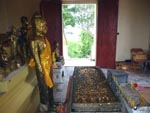 This is in a nice little pagoda at the top of Nang Buat Hill. Inside is a replica of the Lord Buddha's
Footprint. The original is housed in Saraburi. It is a cast of a natural impression found in limestone rock
that resembles a very large footprint. In 1620 a group of Thai monks on pilgrimage in Sri
Lanka were told that the Lord Buddha's Footprint could be found in Thailand. When this rock
was discovered in Saraburi it was declared a Buddhist shrine. The worshippers like to stick gold foil and place coins on the artifact for good luck.
This is in a nice little pagoda at the top of Nang Buat Hill. Inside is a replica of the Lord Buddha's
Footprint. The original is housed in Saraburi. It is a cast of a natural impression found in limestone rock
that resembles a very large footprint. In 1620 a group of Thai monks on pilgrimage in Sri
Lanka were told that the Lord Buddha's Footprint could be found in Thailand. When this rock
was discovered in Saraburi it was declared a Buddhist shrine. The worshippers like to stick gold foil and place coins on the artifact for good luck.
The hill is 100m high and you must climb 227 steps to reach the top. In truth, when you reach the top the pagoda and artifact are not all that exciting. However it is a fun climb and you do have good views of the surrounding countryside.
To find the shrine drive out of Nakhon Nayok on route 3049 for approx 6km and then turn right at the traffic lights (the same traffic lights where you turn left for Ganasha Park). The shrine is approx 3km on the left.
Wat Pa Sri Tawon Nimit
 This is a beautiful shrine but you are going to have to go deep into the backwoods to find it. It is strange to venture so deep into Nakon Nayok's woodlands and then come upon this gleaming white shrine. Inside is a simple hall with a golden Buddha.
This is a beautiful shrine but you are going to have to go deep into the backwoods to find it. It is strange to venture so deep into Nakon Nayok's woodlands and then come upon this gleaming white shrine. Inside is a simple hall with a golden Buddha.
The building of this shrine was initiated by his Majesty the King and a leading monk. It acts as a wellness and peace centre and is also a location where many young Thai men do their spell as a monk. It is normal for Thai males to spend a period of their lives as a monk which is almost a rite of passage to adulthood.
To find it, follow the directions above to Lord Buddha's footprint and then keep going to the end of the road. Turn right and then immediately left. Follow this winding country road for 6 kilometers and you will come to the entrance to the temple. If you miss the entrance to the temple and keep going this road stops at Klong Si Siad Reservoir just half a kilometer further on.
As you enter the temple grounds you pass a traditional Thai temple and then turn left passed a primary school and vegetable garden. Keep going along the track into the woods and you come to a beautiful secluded area with some small lakes and a few small shrines. Wander around and in the middle of the woods you find this splendid white shrine.
Huai Prue and Sai Thong Reservoirs
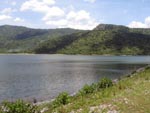 It
is a nice drive out to these reservoirs and there are several interesting
temples on the way. The reservoirs are shallow but cover a wide area.
It is a beautiful location, surrounded by hills.
It
is a nice drive out to these reservoirs and there are several interesting
temples on the way. The reservoirs are shallow but cover a wide area.
It is a beautiful location, surrounded by hills.
Sai Thong reservoir particularly is well and truly in the forest. There is a very nice resort by this reservoir - Rabiangprai Valley Resort .
The Tourism Authority of Thailand has plans to develop the area into a water sports center with rowing, sailing and other activities. However, generally there is very little going on here apart from a little fishing and the odd walker.
You reach the reservoirs by taking route 3049 out of Nakhon Nayok town towards Sarika Waterfall. 1km out of town, take a left onto Khao Thurian Road and follow it for 11km.
Chulachomklao Royal Military Academy
This is a large Thai military cadet training centre but visitors are welcome. Entrance is free but there are small charges for some of the attractions inside. There are several attractions in the grounds. When you enter you will be asked to leave some form of ID at the checkpoint. A driving licence, Thai ID card or passport will suffice.
Immediately after the checkpoint there is a tourism office and shop on the right. You can get information here about the academy and arrange to do some of the activities such as the parachute training jump. The grounds are large so you will need transport. You can drive around in your car or you can rent bikes at the tourist center. The attractions include:
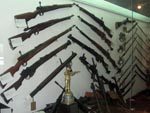 100
Year Royal Military Academy Museum: This military museum contains
exhibits of various weapons, uniforms and other military artifacts. There
are many exhibits from Thai military history and some international exhibits.
Unfortunately, the museum is very much directed at the local tourists and
most of the explanatory texts are only written in Thai. It is still worth
visiting. Entrance is 20-baht.
100
Year Royal Military Academy Museum: This military museum contains
exhibits of various weapons, uniforms and other military artifacts. There
are many exhibits from Thai military history and some international exhibits.
Unfortunately, the museum is very much directed at the local tourists and
most of the explanatory texts are only written in Thai. It is still worth
visiting. Entrance is 20-baht.
King Rama V Monument: This monument is at the general headquarters of the academy. The circular pavilion is a recreation area for the military cadets. It was built in honour of His Majesty King Rama V who was the founder of the academy. In the center is a sculpture of King Rama V.
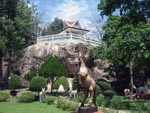 Shrine
of Khun Dan: A lovely little shrine perched on a small rock outcrop.
The shrine is over 300-years old and is dedicated to a Nakhon Nayok army
general and war hero. There is a small souvenir shop and you can climb the
steps at the back of the rock to reach the shrine.
Shrine
of Khun Dan: A lovely little shrine perched on a small rock outcrop.
The shrine is over 300-years old and is dedicated to a Nakhon Nayok army
general and war hero. There is a small souvenir shop and you can climb the
steps at the back of the rock to reach the shrine.
Golf Course: The academy includes an 18-hole golf course and driving range. It is open to the public and there is a golf-shop and retaurant.
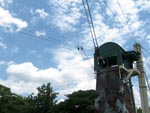 Others:
You can have a go at a parachute drill by jumping down a cable slide - 50-baht.
There is also a sports stadium and 25-meter swimming pool. There is a small
waterfall at the back of the grounds.
Others:
You can have a go at a parachute drill by jumping down a cable slide - 50-baht.
There is also a sports stadium and 25-meter swimming pool. There is a small
waterfall at the back of the grounds.
Ban Dong Lakhon Archeological Site
This archeological site is located 9km south of Nakon Nayok town. It is the site of an old Thai town from the Khmer period. It was declared a national historical site in 1935. It is surrounded by earthen walls and culverts with canals all around. Historians believe the town's people abandoned it in the 14th century AD, when they migrated to live along Nakon Nayok's waterways.
The ancient town was 700 x 800 meters and had four city gates facing each direction. The canal and ditches show the community knew how to divert and store water.
Ongkharak Plant Market
Ongkharak district is on highway 305 between Nakhon Nayok and Rangsit. It is home to Thailand's largest plant market. There is a 4.5 kilometer stretch of plant nurseries. You will find an amazing range of plants and flowers at absolute bargain prices.
Ongkharak University Hospital
Not really an attraction, this is more a point of interest. Srinakharinwirot University Hospital is a large hospital on highway 305 at Ongkharak. The hospital is so large that it looks a little incongruous in such a quiet area so we sometimes get people asking why it is there. It is actually a government funded medical training hospital. There are doctors on call 24-hours a day so it is worth keeping in mind if you have any medical problems while you are in the area.
Local Fruit
You will see vendors selling a wide array of locally grown fruit. Some of the local specialities include:
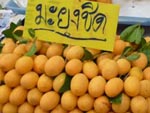 Sweet Plum Mango (Maprang): This is the most well known
fruit of Nakhon Nayok. It is a sweet fruit with a texture like apricot.
The peel is slightly sour and can be removed if preferred. The fruit is in season
from February to April. There is another very similar variety as shown in the picture called ma-yong.
Sweet Plum Mango (Maprang): This is the most well known
fruit of Nakhon Nayok. It is a sweet fruit with a texture like apricot.
The peel is slightly sour and can be removed if preferred. The fruit is in season
from February to April. There is another very similar variety as shown in the picture called ma-yong.
Pomello (Som-o): These are similar to grapefruit in appearance but drier and sweeter.
Jack Fruit (ka-noon): These big ugly brutes are the largest tree borne fruit in the world. They are rather smelly and unattractive but once the fruits have been extracted, they are crisp and fresh tasting.
Sweet Plum Mango and Nakhon Nayok Products Fair
This annual fair is timed to coincide with the harvesting season of Nakhon Nayok's speciality fruit, the sweet plum mango. It is held from February to April on Suwannason Road in front of the city hall. It is held to promote the fruit and other local products and handicrafts.
Nightlife
Nakhon Nayok is not renowned for its nightlife but there are a few bars around to help you pass the evenings. There are a couple of lively bars just out of town on route 3049. There is a Thai country music bar called Baan Nam Sup just out of town on the left before you reach the cross road traffic lights. It is very popular with the locals and has a full house every night.
A little further out of town, after the traffic lights is Mixers Pub. It is very popular at the weekends with the young Bangkok crowd. They also have live Thai music but it is more modern dance orientated music. They also have a garden area outside and big TV screens if you want to see the football or other sports events. These bars stay open to around 1am.
There are several pleasant restaurants and bars in the area closer to the waterfalls and resorts. These are catering to the holiday makers and the kitchens out here tend to close around 10pm and the bars by midnight.

